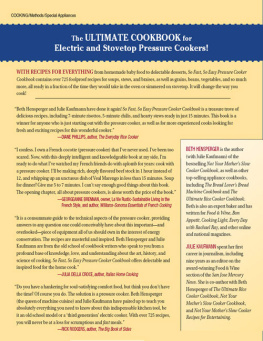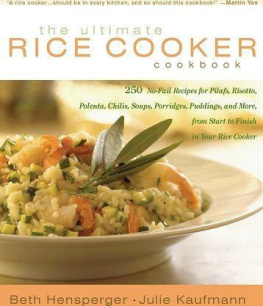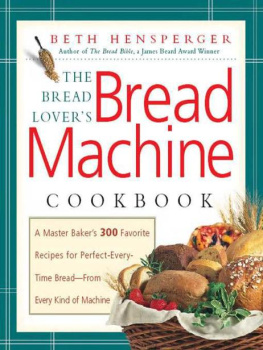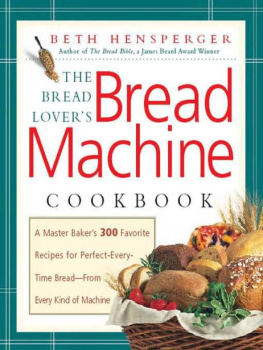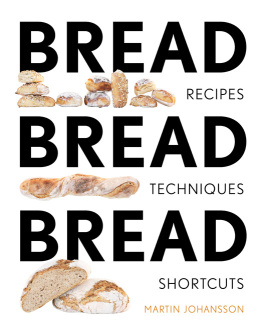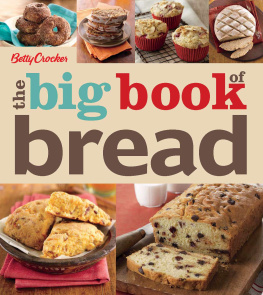

FOR STEVE
Text copyright 1999 by Beth Hensperger. Illustrations copyright 1999 by Harry Bates. All rights reserved. No part of this book may be reproduced in any form without written permission from the publisher.
ISBN 978-1-4521-3826-8
The Library of Congress has cataloged the previous edition as follows:
Hensperger, Beth.
The bread bible: Beth Henspergers 300 favorite recipes.
p.cm.
Includes index.
ISBN 0-8118-1686-9 (hc)
1. Bread.I. Title
TX769.H442 1999
641.8'15dc2198-22374
CIP
PRINTED IN THE UNITED STATES OF AMERICA
DESIGNED BY JILLY SIMONS, KELLY SIMPSON,
AND JENNIFER CULLEN, CONCRETE, CHICAGO
TYPESETTING BY JAIME ROBLES
CHRONICLE BOOKS
680 SECOND STREET
SAN FRANCISCO,
CALIFORNIA 94107
WWW.CHRONICLEBOOKS.COM
ACKNOWLEDGMENTS
Many thanks to my editor, Bill LeBlond, who put this book together and oversaw all aspects of the project with great patience and a discerning eye; assistant editor, Sarah Putman, who took care of the little details; Susan Derecskey, who organized and copyedited the mountain of material; Lisa Howard, our ever-diligent word processor; Roberta Bobbe Torgerson, who generously retested recipes with great efficiency; my friends Lynn Alley, Carole Cesario, Jesse Cool, Mary Anne McCready, Johanna Miller, and Suzanne Rosenblum for their thoughtful opinions and for boosting my spirits; and Martha Casselman, my loyal agent, to whom I owe heartfelt thanks and appreciation for her literary acumen, professional insights, and never-wavering moral support.
THE ART AND SCIENCE
of Good Baking
Bread baking has somehow taken on a mysterious quality, making it seem an intimidating act for many people. The secret to making good bread is that there is no secret. Let your imagination help you break any rules you imagine exist to daunt you.
JACQUELINE DEVAL , Reckless Appetites
(Ecco Press, 1993)
The simple pleasure of savoring homemade fresh bread reminds us of how wonderful the basic integrity of premium-quality ingredients is. Of all the cooking processes, baking bread is regarded with greatest love by its practitioners as well as with the greatest anxiety by the uninitiated. Successful baking combines the elements of a balanced recipe, proper equipment, and good ingredients with skilled hands and a dash of imagination.
After decades of teaching baking bread, I have noticed how seriously home bakers take their skills. They are eager to give their breads a personal touch and expand their skills, yet need to be innovative and playful at the same time. I wanted to create a sourcebook for serious home bakers that would, in addition, be a good place for occasional holiday bakers who are in the process of slowly building their technical expertise to find a recipe as well. I wanted to present a text that is readable, yet infused with my own passion for baking.
In a way, I have returned to my roots here. These are truly my best recipes culled from my earliest to my most recent bread books: from good old-fashioned white breads, the mainstay of the American diet, to time-saving food processor doughs; information on sour starters; popular pizza and flatbreads, the easiest breads to make; the best homemade croissants; and a guide for adapting recipes to the bread machine for the connoisseur who doesnt want to get flour on his counter.
Also in this book the baker will find extravagant celebration breads; lots of flavorful, healthful daily loaves; savory main-dish breads; and breakfast rolls. There are lots of American-style breads, baked in the familiar rectangular-loaf shape and tending to be a bit sweeter and richer than their free-form, crusty European ancestors. There are many best-of-the-best quick breads, very much like cakes in that they demand precise amounts of liquid, leavening, flour, fat, and flavorings. Yet they offer something modern bakers value: ease of preparation in a short period of time.
Youll also find the imaginative use of whole grains, cereals, and flours in many of these loaves, contributing to the new flavors, aromas, and textures modern bakers crave. At the same time all the recipes reflect a natural way to provide your diet with more dietary fiber, a key element in health. Baking your own bread is an easy avenue toward a healthy, well-balanced diet.
My repertoire has always included as many classic yeasted breads solidly based in traditional technique, no matter how exotic or humble the ingredients. Each recipe in this book is designed to stimulate a renewed interest in the art of baking. Do you think that making yeast bread is too time consuming or too difficult? Do such bakers terms as proofing, fermenting, sponge, and second rise seem like a foreign language? This book can answer your questions. Detailed instructions are given for mixing and kneading by hand, by heavy-duty electric mixer, with a food processor, and with a bread machine.
There are no trick recipes or bewildering complicated techniques in this book. There are, on the other hand, lots of little tips, things often omitted precisely because they are so simple. Detailed information also includes comprehensive mixing and baking techniques, notes detailing dough makeup and assembly, as well as helpful information on ingredients. I care as much about the understanding that goes into the bread making craft as the disciplined performance necessary to get a loaf in and out of the oven. A good baker doesnt need to master a great many recipes to be proficient; one good unpretentious, yet well-executed white bread recipe is the basis for everything from wholesome loaves to dinner rolls, hamburger and hot dog buns, and sweet breads.
I want you, as a reader, to let go of the feeling that you have to bake. You can also enjoy reading or browsing in this book, then head out to your favorite bakery or market for an appetizing bread, muffin, biscuit, croissant, or flatbread to satisfy your urge. Small artisanal bakeries and even some larger scale commercial firms produce breads that are as nutritious and delicious as any homemade loaf. It defeats the purpose to bake under pressure or with a feeling of impending doom. But to enjoy on the spot your own baby brioche hot from the oven, a perfect biscuit, crusty country loaf, or a spice-scented breakfast bread or coffee cake, you must bake yourself.
So often I have been asked how I learned to bake. I really started baking in my late teens for my boyfriend, Steve; he encouraged me by happily eating absolutely everything I baked. Baking for someone you love is the core of a home bakers impetus; a sometimes difficult task is turned into a nourishing labor of love when the care you put into it is appreciated. But it was the repetitive baking daily for seven years in a small restaurant that taught me my trade; that is how I built my confidence as a baker. I went from being unable to control a large mass of dough on the work table and wondering what to do with a dough that did not rise in time to be baked for lunch to being very confident with a repertoire of two dozen loaves of my own invention. I was able to develop my skills directly from the experience of baking the same recipe repeatedly over the years, some well over a thousand times.
In response to requests, I began teaching workshops out of the bakery at night. Later, and for the next thirteen years, I taught at local cooking schools. This was an excellent testing ground for finding the best recipes and techniques through the feedback of hundreds of students.
Next page

